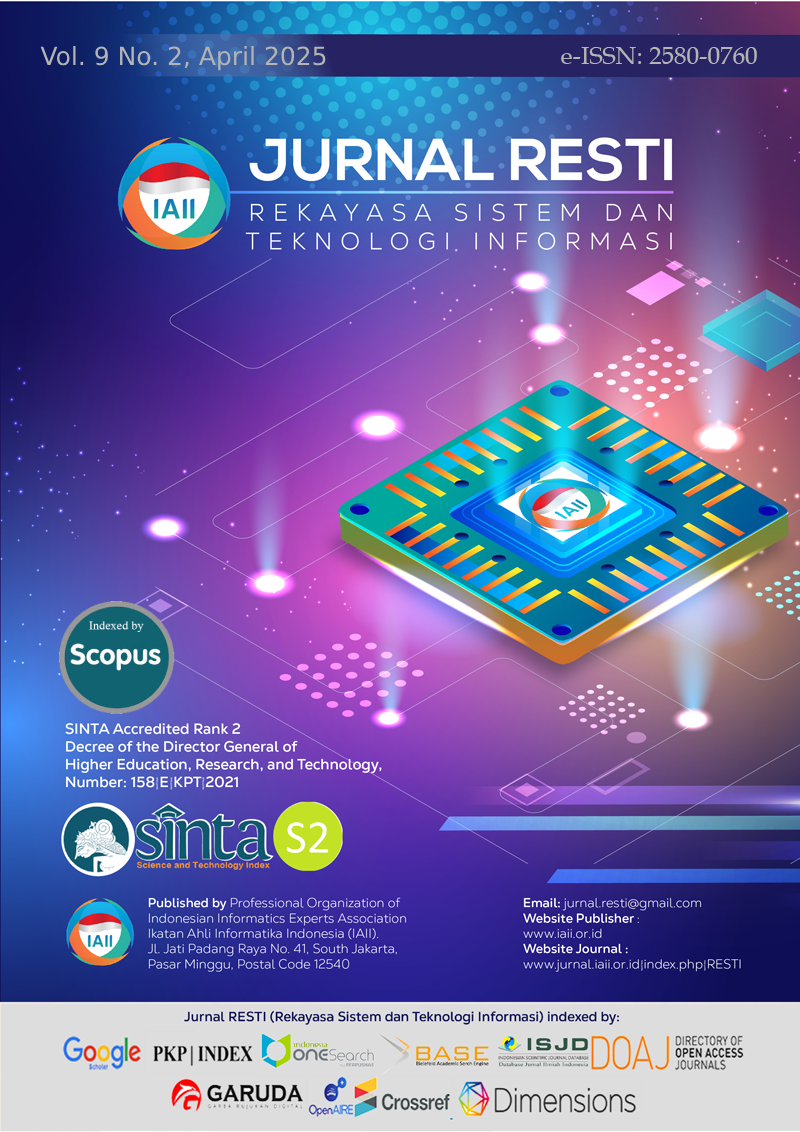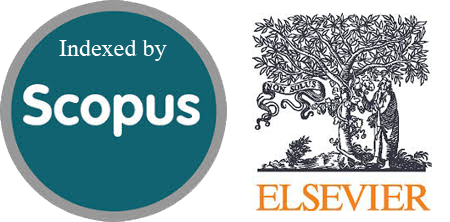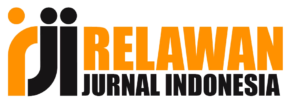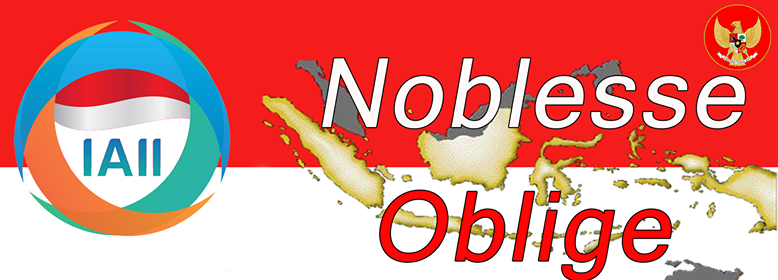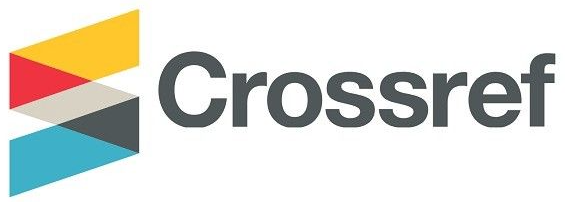Enhancing Problem-Solving Reliability with Expert Systems and Krulik-Rudnick Indicators
Abstract
Problem-solving is one of the skills needed in the 21st century, but there is a significant gap between the ideal conditions and the reality of students' problem-solving skills. One method that can improve students' problem-solving skills is Krulik and Rudnick, but implementing this method with an expert system to improve problem-solving skills is still limited. This research aims to build an expert system to determine the level of problem-solving using Krulik and Rudnick's problem-solving indicators processed using the forward chaining and certainty factor algorithms. The study had five stages: data analysis, rule generation, certainty measurement, prediction, and testing. The data was processed by developing 5 Krulik and Rudnick problem-solving indicators into 35 statements. Each statement was categorized using Forward Chaining by producing three rules: low, medium, and high. The problem-solving level obtained is calculated using the Certainty Factor for a confidence value. The system's prediction results were evaluated using a confusion matrix, resulting in an accuracy of 80%, a precision of 92%, and a recall of 85%, indicating the system's reliable performance in measuring the level of problem-solving. This research can be used as a reference to support problem-solving in various more advanced educational and professional environments.
Downloads
References
A. Oke and F. A. P. Fernandes, “Innovations in teaching and learning: Exploring the perceptions of the education sector on the 4th industrial revolution (4IR),” J. Open Innov. Technol. Mark. Complex., vol. 6, no. 2, 2020, doi: 10.3390/JOITMC6020031.
A. Aristovnik, D. Keržič, D. Ravšelj, N. Tomaževič, and L. Umek, “Impacts of the COVID-19 Pandemic on Life of Higher Education Students: A Global Perspective,” Sustain., vol. 12, no. 20, pp. 1–34, 2020.
P. S. Aithal and A. K. Maiya, “Innovations in Higher Education Industry – Shaping the Future,” Int. J. Case Stud. Business, IT, Educ., vol. 7, no. 4, pp. 294–322, 2023, doi: 10.47992/ijcsbe.2581.6942.0321.
S. D. Abdul Bujang, A. Selamat, O. Krejcar, P. Maresova, and N. T. Nguyen, “Digital learning demand for future education 4.0-case studies at Malaysia education institutions,” Informatics, vol. 7, no. 2, pp. 1–11, 2020, doi: 10.3390/informatics7020013.
R. Prajapati, B. Sharma, and D. Sharma, “Significance Of Life Skills Education,” Contemp. Issues Educ. Res., vol. 10, no. 1, pp. 1–6, 2016, doi: 10.19030/cier.v10i1.9875.
W. Strielkowski, V. Grebennikova, A. Lisovskiy, G. Rakhimova, and T. Vasileva, “AI-driven adaptive learning for sustainable educational transformation,” Sustain. Dev., no. September, pp. 1–27, 2024, doi: 10.1002/sd.3221.
G. M. Slavich and P. G. Zimbardo, “Transformational Teaching: Theoretical Underpinnings, Basic Principles, and Core Methods,” Educ. Psychol. Rev., vol. 24, no. 4, pp. 569–608, 2012, doi: 10.1007/s10648-012-9199-6.
OECD, OECD Digital Education Outlook 2023: Towards an Effective Digital Education Ecosystem. 2023. [Online]. Available: https://www.oecd-ilibrary.org/education/oecd-digital-education-outlook-2023_c74f03de-en
K. K. de S. OLIVEIRA and R. A. C. de SOUZA, “Digital Transformation towards Education 4.0,” Informatics Educ., vol. 21, no. 2, pp. 283–309, 2022, doi: 10.15388/infedu.2022.13.
A. Dilekçi and H. Karatay, “The effects of the 21st century skills curriculum on the development of students’ creative thinking skills,” Think. Ski. Creat., vol. 47, p. 101229, 2023, doi: 10.1016/j.tsc.2022.101229.
T. Tang, V. Vezzani, and V. Eriksson, “Developing critical thinking, collective creativity skills and problem solving through playful design jams,” Think. Ski. Creat., vol. 37, no. August, 2020, doi: 10.1016/j.tsc.2020.100696.
M. Perrow, “‘Welcome to the Real World’: Navigating the Gap Between Best Teaching Practices and Current Reality,” 2013, Taylor & Francis. doi: 10.1080/17425964.2013.833902.
C. S. Große, “Learning to solve story problems—supporting transitions between reality and mathematics,” Eur. J. Psychol. Educ., vol. 29, no. 4, pp. 619–634, 2014, doi: 10.1007/s10212-014-0217-6.
N. Inoue, The Issue of Reality in Word Problem Solving: Learning from Students’ Justifications of “Unrealistic” Solutions to Real Wor(l)d Problems. Brill, 2009. doi: 10.1163/9789087909383_013.
M. Purbaningrum, E. Arliani, S. Ramadhan, and N. L. Azizah, “Tracing Indonesian students’ mathematical literacy through the minimum competency assessment (AKM): A literature review,” in The 2nd International Conference of Mathematics Education, Learning, and Application, 2024, p. 040006. doi: 10.1063/5.0241707.
M. Tohir, Susanto, Hobri, Suharto, and Dafik, “Students’ Creative Thinking Skills in Solving Mathematics Olympiad Problems Based on Problem-Solving Polya and Krulik-Rudnick Model,” Adv. Sci. Lett., vol. 24, no. 11, pp. 8361–8364, 2018, doi: 10.1166/asl.2018.12563.
H. Suryani, A. Setiani, and N. Agustiani, “Gamification of Mathematics Teaching Materials to Improve Problem Solving and Critical Thinking Ability: The Experts’ Assessment,” Educ. Adm. Theory Pract., vol. 30, no. 4, pp. 819–833, 2024, doi: 10.53555/kuey.v30i4.666.
I. H. Raduan, “Error analysis and the corresponding cognitive activities committed by year five primary students in solving mathematical word problems,” Procedia - Soc. Behav. Sci., vol. 2, no. 2, pp. 3836–3838, 2010, doi: 10.1016/j.sbspro.2010.03.600.
I. I. Mahazir, M. N. Norazah, D. Rosseni, A. R. A. Arif, and C. R. Ridzwan, “Design and Development Performance-based into Mobile Learning for TVET,” Procedia - Soc. Behav. Sci., vol. 174, pp. 1764–1770, 2015, doi: 10.1016/j.sbspro.2015.01.835.
L. C. Pratomo, Siswandari, and D. K. Wardani, “The Effectiveness of Design Thinking in Improving Student Creativity Skills and Entrepreneurial Alertness,” Int. J. Instr., vol. 14, no. 4, pp. 695–712, 2021, doi: 10.29333/iji.2021.14440a.
Suminten and Rani, “Sistem Pakar Diagnosa Kerusakan Laptop Menggunakan Metode Forward Chaining,” Rekayasa Sist. dan Teknol. Inf., vol. 1, no. 1, pp. 19–25, 2018.
M. K. Kim, A. Zouaq, and S. M. Kim, “Automatic Detection of Expert Models: The Exploration of Expert Modeling Methods Applicable to Technology-Based Assessment and Instruction Author,” Comput. Educ., vol. 101, pp. 55–69, 2016, doi: 10.1016/j.compedu.2016.05.007.
F. Inusah, Y. M. Missah, U. Najim, and F. Twum, “Integrating expert system in managing basic education: A survey in Ghana,” Int. J. Inf. Manag. Data Insights, vol. 3, no. 1, p. 100166, 2023, doi: 10.1016/j.jjimei.2023.100166.
S. A. Abdymanapov, M. Muratbekov, S. Altynbek, and A. Barlybayev, “Fuzzy Expert System of Information Security Risk Assessment on the Example of Analysis Learning Management Systems,” IEEE Access, vol. 9, pp. 156556–156565, 2021, doi: 10.1109/ACCESS.2021.3129488.
E. T. Saadyah and S. Winiarti, “Sistem Pakar Untuk Mengidentifikasi Permasalahan Siswa dan Menentukan Solusinya dengan Menggunakan Metode Naïve Bayes Classifier,” JSTIE (Jurnal Sarj. Tek. Inform., vol. 7, no. 2, p. 129, 2019, doi: 10.12928/jstie.v7i2.15823.
F. D. de la Peña Esteban, J. A. Lara Torralbo, D. Lizcano Casas, and M. A. Martínez Rey, “Expert system for problem solving in distance university education: The successful case of the subject ‘operations management,’” Expert Syst., vol. 36, no. 5, pp. 1–13, 2019, doi: 10.1111/exsy.12444.
O. Eshbayev and M. Nasiba, “Innovating Higher Education by Using Education Technology and Expert Systems: Pathways to Educational Innovation,” Int. J. Soc. Sci. Res. Rev., vol. 6, no. 6, pp. 112–120, 2023, doi: 10.47814/ijssrr.v6i6.1217.
J. Karnando and L. Slamet, “Sistem Pakar Penentuan Gaya Belajar Siswa Dengan Metode Forward Chaining Berbasis Web,” IT J. Res. Dev., vol. 5, no. 1, pp. 32–44, 2020, doi: 10.25299/itjrd.2020.vol5(1).4740.
Y. D. Arimbi, D. Widiastuti, and I. Zulmi, “Sistem Pakar Berbasis Web Untuk Menentukan Gaya Belajar Visual, Auditory, Kinestetik Pada Remaja,” J. Ilm. Teknol. dan Rekayasa, vol. 26, no. 3, pp. 227–239, 2021, doi: 10.35760/tr.2021.v26i3.2713.
N. Sunaryo, Y. Yuhandri, and S. Sumijan, “Sistem Pakar Menggunakan Metode Certainty Factor dalam Identifikasi Pengembangan Minat dan Bakat Khusus pada Siswa,” J. Sistim Inf. dan Teknol., vol. 3, pp. 48–55, 2021, doi: 10.37034/jsisfotek.v3i2.43.
D. E. Lestari, A. Amrullah, N. Kurniati, and S. Azmi, “Pengaruh Motivasi Belajar Siswa terhadap Kemampuan Pemecahan Masalah Matematika Pada Materi Barisan dan Deret,” J. Ilm. Profesi Pendidik., vol. 7, no. 3, pp. 1078–1085, 2022, doi: 10.29303/jipp.v7i3.719.
B. Boulay, “N . J . Nilsson , Artificial Intelligence : A New Synthesis T . Dean , J . Allen and Y . Aloimonos , Artificial Intelligence : Theory and Practice D . Poole , A . Mackworth and R . Goebel , Computational Intelligence : A Logical Approach S . Russell and P,” Artif. Intell., vol. 125, pp. 227–232, 2001, doi: 10.1016/s0004-3702(00)00064-3.
P. Hasan and E. Pawan, “Optimizing the Combination of Forward Chaining and Certainty Factor Methods in Early Diagnosis of Tertiana and Tropical Malaria Diseases,” Int. J. Intell. Syst. Appl. Eng., vol. 12, no. 11s, pp. 502–511, 2024.
H. J. Pasman and W. J. Rogers, “How to treat expert judgment? With certainty it contains uncertainty!,” J. Loss Prev. Process Ind., vol. 66, no. June, p. 104200, 2020, doi: 10.1016/j.jlp.2020.104200.
J. Chaki, “Certainty Factor and Evidential Reasoning to Handle Uncertainty in Artificial Intelligence,” in Handling Uncertainty in Artificial Intelligence, Singapore: Springer Nature, 2023, pp. 37–45.
Z. Zhao, Z. yuan Liu, and C. Xu, “Slope Unit-Based Landslide Susceptibility Mapping Using Certainty Factor, Support Vector Machine, Random Forest, CF-SVM and CF-RF Models,” Front. Earth Sci., vol. 9, no. March, pp. 1–16, 2021, doi: 10.3389/feart.2021.589630.
K. Kaur, D. Bhalla, and J. Singh, “Fault Diagnosis for Oil Immersed Transformer Using Certainty Factor,” IEEE Trans. Dielectr. Electr. Insul., vol. 31, no. 1, pp. 485–494, 2024.
A. S. Sembiring et al., “Implementation of Certainty Factor Method for Expert System,” J. Phys. Conf. Ser., vol. 1255, no. 1, 2019, doi: 10.1088/1742-6596/1255/1/012065.
Bruce G. Buchanan and E. H. Shortliffe, Rule-based Expert System: The MYCIN Experiments of the Stanford Heuristic Programming Project, First Edit. Addison-Wesley, 1985.
S. Chandra, Y. Yunus, and S. Sumijan, “Sistem Pakar Menggunakan Metode Certainty Factor untuk Estetika Kulit Wanita dalam Menjaga Kesehatan,” J. Inf. dan Teknol., vol. 2, pp. 4–9, 2020, doi: 10.37034/jidt.v2i4.70.
M. Irfan, P. Alkautsar, A. R. Atmadja, and Wildan Budiawan Zulfikar, “Diagnosis of Asthma Disease and The Levels using Forward Chaining and Certainty Factor,” J. RESTI (Rekayasa Sist. dan Teknol. Informasi), vol. 6, no. 5, pp. 761–767, 2022, doi: 10.29207/resti.v6i5.4123.
L. E. Pommé, R. Bourqui, R. Giot, and D. Auber, “Relative Confusion Matrix: An Efficient Visualization for the Comparison of Classification Models,” in Artificial Intelligence and Visualization: Advancing Visual Knowledge Discovery, Switzerland: Springer Nature, 2024, pp. 223–243.
T. Dreyfus and T. Eisenberg, “On Different Facets of Mathematical Thinking,” in The Nature of Mathematical Thinking, 2012. doi: 10.4324/9780203053270-19.
K. Bariyah and E. Retnowati, “How to analyze students’ logical-mathematical intelligence in problem solving based on SOLO taxonomy,” in Frontiers in Industrial and Applied Mathematics: FIAM2022, AIP Publishing, 2024. doi: 10.1063/5.0133822.
Copyright (c) 2025 Jurnal RESTI (Rekayasa Sistem dan Teknologi Informasi)

This work is licensed under a Creative Commons Attribution 4.0 International License.
Copyright in each article belongs to the author
- The author acknowledges that the RESTI Journal (System Engineering and Information Technology) is the first publisher to publish with a license Creative Commons Attribution 4.0 International License.
- Authors can enter writing separately, arrange the non-exclusive distribution of manuscripts that have been published in this journal into other versions (eg sent to the author's institutional repository, publication in a book, etc.), by acknowledging that the manuscript has been published for the first time in the RESTI (Rekayasa Sistem dan Teknologi Informasi) journal ;

